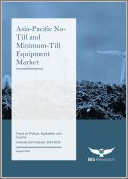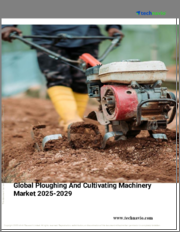
|
시장보고서
상품코드
1532303
아시아태평양의 무경운 및 최소경운장비 시장 : 제품별, 용도별, 국가별 - 분석과 예측(2023-2028년)Asia-Pacific No-Till and Minimum-Till Equipment Market: Focus on Product, Application, and Country - Analysis and Forecast, 2023-2028 |
||||||
아시아태평양의 무경운 및 최소경운장비 시장 규모는 2023년에는 8억 560만 달러에 달했습니다.
이 시장은 CAGR 7.35%로 성장하여 2028년에는 11억 4,850만 달러에 달할 것으로 예측됩니다. 무경운 및 최소경운장비 시장은 세계 농업계에서 기술진보가 계속되고 있기 때문에 예측기간 중에 급성장이 전망되고 있습니다. 코팅 작물 전략은 토양의 건전성과 비옥도를 높여 무경운 및 최소경운장비 산업의 성장을 뒷받침합니다. 농부는 침식을 방지하고 잡초를 억제하고 유기물을 늘리기 위해 코팅 작물을 사용합니다.
| 주요 시장 통계 | |
|---|---|
| 예측 기간 | 2023-2028년 |
| 2023년 평가액 | 8억 560만 달러 |
| 2028년 예측 | 11억 4,850만 달러 |
| CAGR | 7.35% |
아시아태평양의 무경운 및 최소경운농법시장은 지속가능한 농법 채용 확대로 급속히 확대되고 있습니다. 무경운 및 최소경운농법은 토양의 교란을 최소화하여 토양 수분을 보전하고 침식을 줄이고 토양의 건전성을 향상시키는 데 도움이 됩니다. 이러한 농법은 투입 비용을 억제하면서 작물 수율을 늘릴 수 있기 때문에 아시아태평양 농가들 사이에서 인기를 끌고 있습니다.
중국, 인도, 호주는 정부의 이니셔티브와 보조금이 농부들에게 무경운 농법과 최소 경기 농법을 장려합니다. 기존의 경작 방법이 환경에 미치는 영향에 대한 의식이 높아짐에도 시장 확대를 뒷받침하고 있습니다. 또한 유기농 식품에 대한 수요가 증가하고 농업에서 효율적인 물 관리의 필요성이 이러한 농법의 채용을 뒷받침하고 있습니다.
이 시장에는 시드 드릴이나 플랜터 등 무경운 및 최소경운농업을 위한 폭넓은 기기가 포함되어 있습니다. 이 지역의 주요 기업들은 수요 증가에 대응하기 위해 선진적이고 효율적인 장비를 도입하기 위한 R&D에 투자하고 있습니다. 아시아태평양의 무경운 및 최소경기시장은 대폭적인 성장이 예상되어 농업이해 관계자에게 생산성과 지속가능성을 향상시키는 수많은 기회를 창출합니다.
본 보고서에서는 아시아태평양의 무경운 및 최소경운장비 시장에 대해 조사했으며, 시장 개요와 함께 제품별, 용도별, 국가별 동향 및 시장 진출기업 프로파일 등의 정보를 제공합니다.
목차
조사 범위
주요 요약
제1장 시장
- 업계 전망
- 비즈니스 역학
- 자금 조달과 투자 상황
제2장 지역
- 중국
- 아시아태평양
- 아시아태평양(국가별)
제3장 시장 - 경쟁 벤치마킹 및 기업 프로파일
- 경쟁 벤치마킹
- 경쟁 포지션 매트릭스
- 시장 점유율 분석
- 기업 프로파일
- KUBOTA Corporation
제4장 조사 방법
JHS 24.08.21Introduction to Asia-Pacific No-Till and Minimum-Till Equipment Market
The Asia-Pacific market for no-till and minimum-till equipment was estimated to be worth $805.6 million in 2023 and is projected to grow at a compound annual growth rate (CAGR) of 7.35% to reach $1,148.5 million in 2028. The market for no-till and minimum-till equipment is expected to grow rapidly over the forecast period, owing to ongoing technological advancements in the global agricultural industry. Cover cropping strategies boost growth in the no-till and minimum-till equipment industries by enhancing soil health and fertility. Farmers use cover crops to prevent erosion, control weeds, and increase organic matter.
| KEY MARKET STATISTICS | |
|---|---|
| Forecast Period | 2023 - 2028 |
| 2023 Evaluation | $805.6 Million |
| 2028 Forecast | $1,148.5 Million |
| CAGR | 7.35% |
Market Introduction
The APAC No-Till and Minimum Till market is expanding rapidly, driven by the growing adoption of sustainable agricultural practices. No-till and minimum-till farming methods help to conserve soil moisture, reduce erosion, and improve soil health by minimizing soil disturbance. These practices are gaining popularity among Asia-Pacific farmers due to their ability to increase crop yield while lowering input costs.
In China, India, and Australia, government initiatives and subsidies are encouraging farmers to use no-till and minimum-till farming methods. The growing awareness of the environmental impact of conventional tillage practices has also aided the market's expansion. Furthermore, the growing demand for organic food products and the need for efficient water management in agriculture are driving the adoption of these practices.
The market includes a wide range of equipment for no-till and minimum-till farming, including seed drills and planters. Key players in the region are investing in R&D to introduce advanced and efficient equipment to meet rising demand. The APAC No-Till and Minimum Till market is expected to grow significantly, creating numerous opportunities for agricultural stakeholders to improve productivity and sustainability.
Market Segmentation
Segmentation 1: by Application
- Farms and Agricultural Fields
- Orchards and Vineyards
- Pastures and Grazing Lands
- Nurseries and Urban Agriculture
- Others
Segmentation 2: by Product
- Seed Drills and Planters
- Cover Crop Seeders
- Cultivators and Tillage Equipment
- Precision Agriculture Technologies
- Others
Segmentation 3: by Country
- Japan
- South Korea
- Australia
- Rest-of-Asia-Pacific
How can this report add value to an organization?
Product/Innovation Strategy: In the dynamic landscape of the no-till and minimum-till equipment market, significant advancements are revolutionizing agricultural practices, with a dedicated focus on optimizing farm performance. Harnessing cutting-edge solutions, including AI-driven analytics and real-time monitoring platforms, no-till and minimum-till equipment provide detailed insights into soil health, crop management, and resource utilization. Innovations such as precision agriculture techniques contribute to efficient farming practices, ensuring optimal crop yield and environmental sustainability. The market encompasses a diverse range of solutions, from state-of-the-art planting equipment to precision seeding systems, empowering farmers to enhance operational efficiency and minimize resource utilization effectively.
Growth/Marketing Strategy: The APAC no-till and minimum-till equipment market is undergoing a remarkable transformation, mirroring the growth strategies observed in the server GPU sector. Key players in the industry are strategically expanding their business horizons, fostering collaborations, and entering partnerships to fortify their global presence. This trend aligns with the shift toward climate-smart agriculture, where companies are not only focused on technological advancements but also on sustainable farming practices. The synergy between technology firms and agricultural experts is driving the development of cutting-edge, climate-smart monitoring tools. Joint ventures and collaborative initiatives are instrumental in integrating diverse expertise, ultimately enhancing the market presence of these climate-smart solutions. This collaborative approach is pivotal in creating comprehensive, user-friendly, and efficient solutions for the evolving landscape of no-till and minimum-till agriculture.
Competitive Strategy: In the ever-evolving landscape of the APAC no-till and minimum-till equipment market, manufacturers are diversifying their product offerings to address a wide range of agricultural needs and practices. Comprehensive competitive analysis underscores the specific capabilities of market participants, showcasing their tailored solutions and specialized knowledge in different regions. Collaborations with agricultural research institutions and technology organizations play a crucial role in fostering innovation and steering the continual transformation of the no-till and minimum-till equipment sector.
Table of Contents
Scope of the Study
Executive Summary
1 Markets
- 1.1 Industry Outlook
- 1.1.1 Ongoing Trends
- 1.1.1.1 Expansion of Cover Cropping Techniques for Soil Health Enhancement
- 1.1.1.2 Integration of Digital Farming Platforms for Data-Driven Decision-Making
- 1.1.1.3 Emerging Automation in No-Till and Minimum-Till Equipment
- 1.1.2 Ecosystem/Ongoing Programs
- 1.1.2.1 Consortiums and Associations
- 1.1.2.2 Government Initiatives and their Impacts
- 1.1.1 Ongoing Trends
- 1.2 Business Dynamics
- 1.2.1 Business Drivers
- 1.2.1.1 Environmental Sustainability and Soil Health
- 1.2.1.2 Water Conservation and Efficiency
- 1.2.1.3 Reduced Chemical Usage and Pesticide Management
- 1.2.1.4 Governmental Support and Policy Initiatives
- 1.2.2 Business Challenges
- 1.2.2.1 Initial Capital Investments
- 1.2.2.2 Supply Chain Disruptions in the No-Till and Minimum-Till Equipment Market
- 1.2.2.3 Knowledge and Skill Gap
- 1.2.3 Market Strategies and Developments
- 1.2.3.1 Business Strategies
- 1.2.3.1.1 Product Development and Innovations
- 1.2.3.1.2 Market Development
- 1.2.3.2 Corporate Strategies
- 1.2.3.2.1 Mergers and Acquisitions
- 1.2.3.2.2 Partnerships, Collaborations, Joint Ventures, and Alliances
- 1.2.3.2.3 Others
- 1.2.3.1 Business Strategies
- 1.2.4 Business Opportunities
- 1.2.4.1 Advanced No-Till and Minimum-Till Equipment Technology
- 1.2.4.2 Eco-Friendly Farming Input Supply Chain
- 1.2.5 Case Studies
- 1.2.1 Business Drivers
- 1.3 Funding and Investment Landscape
- 1.3.1 Funding Analysis (by Year)
- 1.3.2 Funding Analysis (by Company)
2 Regions
- 2.1 China
- 2.2 Asia-Pacific
- 2.2.1 Asia-Pacific (by Country)
- 2.2.1.1 South Korea
- 2.2.1.2 Australia
- 2.2.1.3 Japan
- 2.2.1.4 Rest-of Asia-Pacific
- 2.2.1 Asia-Pacific (by Country)
3 Markets - Competitive Benchmarking & Company Profiles
- 3.1 Competitive Benchmarking
- 3.1.1 Competitive Position Matrix
- 3.1.2 Market Share Analysis
- 3.2 Company Profiles
- 3.2.1 KUBOTA Corporation
- 3.2.1.1 Company Overview
- 3.2.1.2 Product and Customer Portfolio Analysis
- 3.2.1 KUBOTA Corporation
4 Research Methodology
- 4.1 Data Sources
- 4.1.1 Primary Data Sources
- 4.1.2 Secondary Data Sources
- 4.2 Market Estimation and Forecast
- 4.2.1 Factors for Data Prediction and Modeling



















